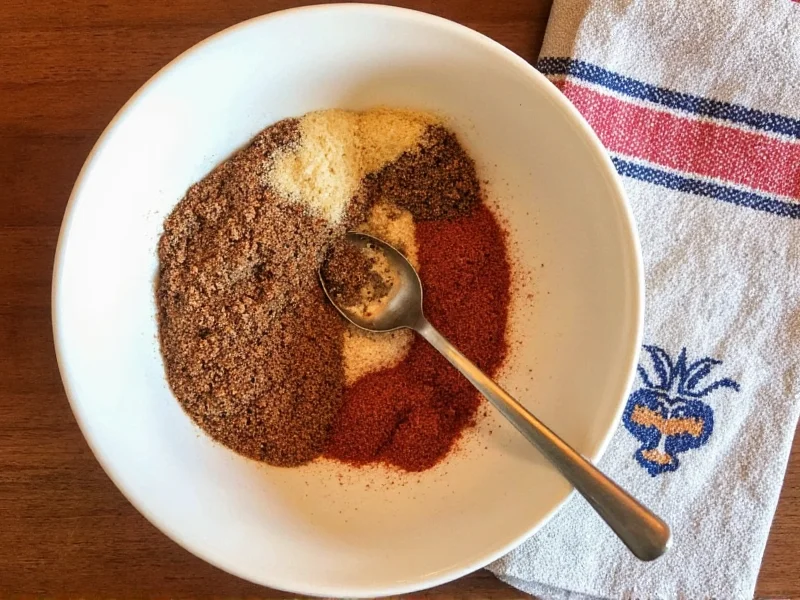Creating your own fajita seasoning eliminates unnecessary additives found in commercial blends while offering complete control over flavor intensity and heat level. This basic spice mix forms the foundation of authentic Tex-Mex fajitas, transforming ordinary chicken, steak, or vegetables into restaurant-quality meals with minimal effort. Unlike store-bought versions that often contain anti-caking agents and excessive sodium, this homemade alternative uses pure pantry staples you likely already have.
The Essential Fajita Seasoning Formula
What makes this particular blend work so well for fajitas? Each component serves a specific purpose in building the complex flavor profile characteristic of authentic fajitas. The combination creates a balanced mix of earthy, smoky, and slightly spicy notes that complement grilled proteins and vegetables perfectly.
| Ingredient | Measurement | Flavor Contribution |
|---|---|---|
| Chili powder | 2 tablespoons | Base earthy flavor with mild heat |
| Ground cumin | 1 tablespoon | Warm, nutty depth (essential for authenticity) |
| Garlic powder | 1 tablespoon | Savory umami backbone |
| Onion powder | 1 tablespoon | Sweet aromatic foundation |
| Paprika | 1 teaspoon | Subtle sweetness and color |
| Dried oregano | 1 teaspoon | Earthy herbal note |
| Salt | 1 teaspoon | Flavor enhancer and tenderizer |
| Black pepper | 1/2 teaspoon | Subtle heat and complexity |
Why This Simple Fajita Seasoning Works
The magic of this easy homemade fajita seasoning recipe lies in its balance. Chili powder provides the signature red color and foundational flavor, while cumin adds the distinctive earthy note that defines authentic fajitas. Many commercial blends skimp on cumin, resulting in a generic 'taco' flavor rather than true fajita character.
Garlic and onion powders deliver consistent savory notes without burning on the grill—unlike fresh garlic which can become bitter when seared at high temperatures. The small amount of oregano provides subtle herbal complexity without overpowering, while paprika enhances color and adds mild sweetness.
Perfecting Your Homemade Fajita Spice Mix
Mix all ingredients thoroughly in a small bowl, breaking up any clumps with a fork. For best results, transfer to an airtight container and let the spices rest for at least 24 hours before use. This crucial step allows the flavors to meld and intensify, creating a more cohesive seasoning blend.
When applying to proteins, use 1½ tablespoons of seasoning per pound of meat. For chicken or steak fajitas, combine the meat with seasoning and 2 tablespoons lime juice or vinegar plus 1 tablespoon oil. The acid helps the spices adhere while tenderizing the meat. Let it marinate for 30-60 minutes at room temperature for optimal flavor penetration—any longer may cause the texture to become mushy.
Customizing Your Simple Fajita Seasoning
One major advantage of making your own fajita seasoning from scratch is complete customization. Adjust these elements based on your preferences:
- Heat level: Add ¼-½ teaspoon cayenne pepper for extra kick, or include 1 teaspoon chipotle powder for smoky heat
- Smokiness: Substitute smoked paprika for regular paprika for deeper flavor Sweetness: Add ½ teaspoon brown sugar to balance acidity when using with chicken
- Garlic intensity: Increase garlic powder to 1½ tablespoons for stronger garlic flavor
- Sodium control: Reduce salt to ½ teaspoon and add more to taste after cooking
Storage and Shelf Life
Store your homemade fajita seasoning in an airtight container away from light and heat. Properly stored, it maintains peak flavor for 3-4 months. While spices don't spoil, their potency diminishes over time. For longest shelf life, consider dividing your batch into smaller containers to minimize air exposure each time you use it.
Check freshness by rubbing a small amount between your fingers and smelling. If the aroma seems weak or dusty, it's time to make a new batch. Never store spice blends in refrigerator as moisture can cause clumping and flavor degradation.
Using Your Seasoning for Perfect Fajitas
For authentic fajita preparation, cook your seasoned protein and vegetables separately. Heat a cast iron skillet or grill pan over high heat until smoking hot. Add oil sparingly (too much causes steaming rather than searing), then arrange meat in a single layer without crowding.
Cook chicken for 5-7 minutes per side, steak for 3-4 minutes per side depending on thickness. Remove meat and let rest while cooking sliced bell peppers and onions until slightly charred but still crisp-tender. Slice meat against the grain and combine with vegetables just before serving.
Troubleshooting Common Issues
Bitter seasoning: Usually caused by old spices or excessive cumin. Use fresher spices and reduce cumin to 2½ teaspoons.
Seasoning burns during cooking: Sugar content in some commercial blends causes this. This simple fajita seasoning recipe contains no sugar, but if adding brown sugar, reduce heat slightly or add it after cooking.
Flavor too mild: Increase chili powder to 2½ tablespoons and add ¼ teaspoon cayenne. Always bloom spices in oil before adding to meat for deeper flavor.











 浙公网安备
33010002000092号
浙公网安备
33010002000092号 浙B2-20120091-4
浙B2-20120091-4